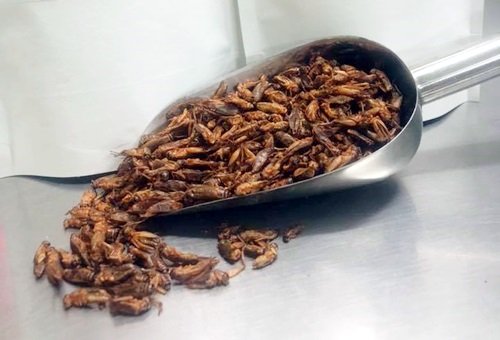Eating insects could improve your health, new data suggest
1116 Views |

By Esther Landhuis
Valerie Stull begins her mornings with a breakfast shake. She blends peanut butter, cocoa powder, banana, soymilk and flax seeds into it. She also sweetens it with honey and stirs in a little extra protein. That last ingredient is a powder made from ground crickets. Her research has shown that these bugs can be good for the gut.
Stull works at the Global Health Institute. It’s based at the University of Wisconsin in Madison. There she studies the overlap between agriculture, the environment and health. She’s part of an emerging group of researchers who study the impacts of eating insects. There’s a formal name for dining on bugs: entomophagy (En-tuh-MAH-fuh-jee).
About two billion people regularly eat insects. That’s almost one in every four. Most North Americans and Europeans tend to find the idea of entomophagy revolting. Yet even in their parts of the world, bug eating is starting to catch on. That’s especially true when the bugs are downed, as Stull’s are, in a form that doesn’t show their eyes, wings and feet.
Some scientists view edible insects as “mini-livestock.” (Livestock refers to animals that can be farmed.) Compared to raising cattle and more traditional livestock, insects need far less land and water. Bugs also are nutritious. They’re packed with protein, vitamins and minerals. Plus, their outer shells contain chitin (KY-tin) — a source of fiber.
High-fiber diets help guard against diabetes, heart disease and some types of cancer. Fruits, leafy greens and whole-grain foods all contain fiber. But the human body cannot digest fiber. Instead, fiber’s health benefits come from serving as a food for the beneficial microbes that live in our gut. Those gut germs make up our microbiome (My-kroh-BY-ohm). They include bacteria that can make us ill and others that boost our health.
The helpful crew breaks fiber into small molecules. These compounds can then boost the immune system, control body weight and even influence mood and emotions. Scientists refer to fiber and other parts of the microbes’ diet as prebiotics. That means they feed good gut bacteria.
It’s easy to confuse the terms prebiotic and probiotic. Probiotics are microbes that are good for you. Yogurt and sauerkraut are examples of foods that contain probiotics. Prebiotics, in contrast, are foods that fuel the growth of helpful gut microbes.
Stull wondered if chitin and other fibers in insects might offer health benefits similar to other fibers found in a typical American diet. To find out, she teamed up with Tiffany Weir. She’s a microbiome scientist at Colorado State University in Fort Collins. Breakfasts enriched with crickets changed the ratio of different microbes in the gut, the two now report. And those changes were in a direction that should boost a diner’s health.
The researchers described the results July 17 in Scientific Reports.
The cricket advantage
Stull and Weir recruited 20 healthy adults for a six-week study. Each morning for the first two weeks, the volunteers dined on chocolate shakes and pumpkin muffins. For half of the group, these foods contained a bonus: 25 grams of cricket powder. For the next two weeks, the volunteers ate whatever they wanted. In the final two weeks, each of the two groups ate what the others had during the first two weeks of the trial.
Before the study started, and again after each two-week period, each volunteer gave blood and provided a fecal sample. The recruits also took a survey that asked about bloating, constipation or feeling some type discomfort after meals.
Back in the lab, the researchers pulled out DNA from each person’s poop. They used a technique known as PCR to look for evidence of bacteria in those feces. The researchers then “read” the DNA sequences and looked for any matches to those for known gut bacteria.
Of 147 bacterial species analyzed, 15 changed after the cricket diet. One of those that changed is Bifidobacterium animalis (BIFF-idd-oh-bak-TEER-ee-um Aa-nih-MAL-is). It prevents diarrhea and other illnesses. Its abundance in poop increased 5.7-fold in the group consuming shakes and muffins with crickets. In contrast, levels of several harmful microbes fell.
These findings suggest that crickets work as prebiotics, says Melissa Agnello. “It’s evidence warranting further study of this novel food source,” she says. Agnello works at uBiome in San Francisco, Calif. This company creates technologies to study the microbiome.
Scientists think prebiotics, which fuel the growth of helpful gut microbes, have longer and larger benefits than probiotics do, Stull says. Probiotics exist in your gut, and you can also add them to your diet, notes Stull. “When you take probiotics, you’re infusing a whole bunch of good bacteria,” she explains. “But if you don’t feed those good bacteria, they’re not going to stick around very long.”
Since cricket was a new food, Agnello says, the participants might have lacked some gut microbes that digest chitin. She suspects the effect would have been larger if the participants’ microbiomes were better equipped from the start to break chitin down into beneficial molecules.
It’s also possible that crickets confer larger benefits to people who eat them regularly. In a future study Stull’s team would like to test that idea. These scientists will begin by looking at the microbiome of people from different parts of the world who have been lifelong insect eaters.
https://www.sciencenewsforstudents.org/article/crickets-breakfast



